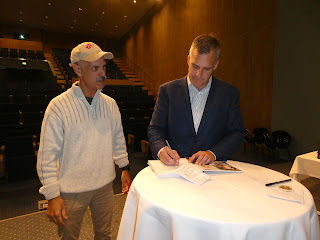In elementary school we had a riddle that went like this:
Q: How many grooves are there on a record?
A: Two - one on each side.
Ortofon (the name of the company) in Nakskov (the name of the Danish town) lives from sound and produces some of the world's best pick-ups for record players. It requires dexterity and deep concentration of 3F union employees (the union I am a member of).
As you may have guessed, this is my loose translation of an article from my monthly 3F union magazine and I am dedicating this story to well known French DJ artist, Esteban.
But before we go on any further, hit this link and listen to this music in the background while you read this very interesting "you'd be surprised" story.
But before we go on any further, hit this link and listen to this music in the background while you read this very interesting "you'd be surprised" story.
From Tokyo to New York, the booming beat of dance music entices guests in the dark. In nightclubs - blue, purple and white flashing lights, spinning round the room, momentarily reveal the faces of the guest as they dance to the inciting rhythms. The disc jockey behind the mixer on the stage is the magic of the music. He does not use hocus-pocus pre-mixed formulas, but instead he uses his hands like "scratching" on vinyl. The sounds together create an entire orchestra of voices and music.
However, the magic of the night starts not in the clubs, rather, they start at the Ortofon company in Nakskov, Lolland (a medium size island south of Copenhagen and just north of Germany) (we drove across the island 2 blogs ago. Look for the letters E, F and G on the map.) It's from this point where the music starts. It's from here that DJ's from around the world get the world's best pick-ups used to mix their music.
THE WORK REQUIRES FEELING
Ortofon's red brick building reveals nothing of the machine noise that the ear meets as soon as you enter the ground floor. Here sits the 56-year-old Lone Sunke. She is the team leader in the magnetic department for 17 full-time employees and 8 young workers. Her team is sitting in rows and concentrate on each their microscopes while their fingers work with tweezers. With surgical precision, they collect the metal thread on a coil roll. 700 copper metal wires are made in the machine, which is among other things, the cause of the noise in the room.
It takes a sense of feeling to work with this because you have to put the coils down over small sticks and the thread is 23 thousandth of a my. (the article does not say what a my is, but I found this: My (Μ μ) is a Greek letter with the sound value [m]. The letter is used as a symbol of permittivity. It is often seen that the letter u is used instead of "my". This is shown by indicating capacity.) "It is thinner than a strand of hair", explains Lone Sunke.
In the magnetism department they produce the popular Q-Bert pickup, made especially for scratch and hip-hop. It is designed in collaboration with the American DJ Q-Bert from San Francisco, CA. "We sell a lot of Q-Bert pickups. There are many different colors and types, such as the OM and 2M model", tells Lone Sunke.




























